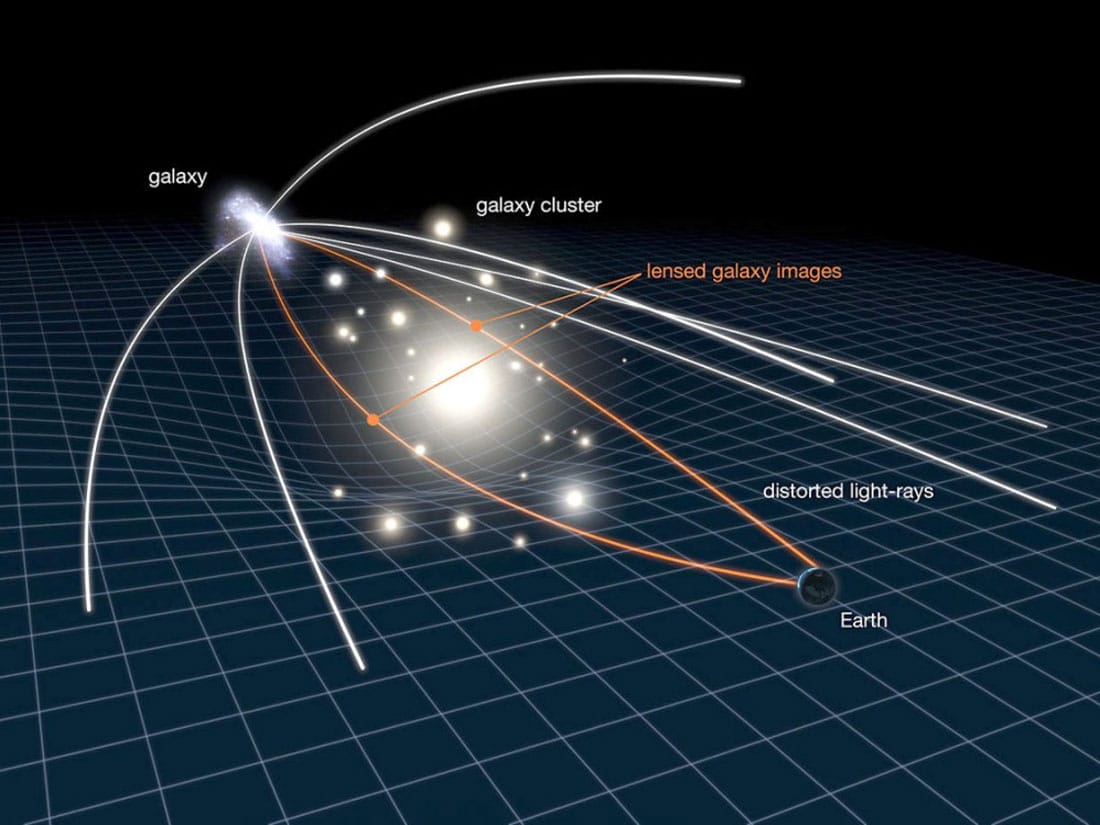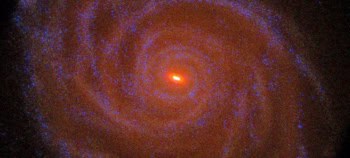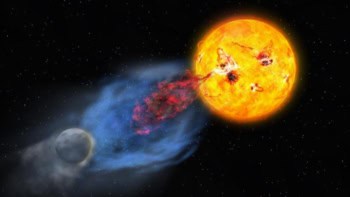Light from distant galaxies is distorted on its journey to us via a vast network of dark matter. By observing this phenomenon, known as gravitational lensing, physicists are able to map the structure of this dark cosmic web, as Catherine Heymans explains
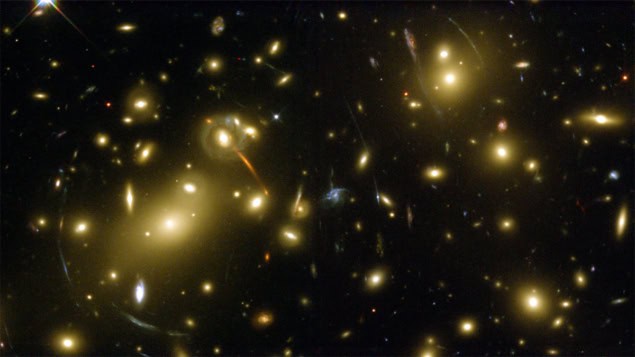
It’s one of the most memorable moments of my career – and not in a good way. I was giving a talk to a room packed full of eminent astrophysicists, but there had been a bit of a childcare crisis, so child number two was sitting grumpily on the front row. I was in full flow, proudly leading up to my new result, when an all-too-familiar voice cut through the air. “She doesn’t know what she’s talking about!”
As time has passed, I have slowly recovered from this mortifying experience, comforted in the realization that for a four year old, my son was being quite astute. You see, I specialize in observing the dark side of our universe – a kind of shadow realm that we can’t see or touch, but which extends throughout the whole universe and even permeates our everyday world.
What we do know about this invisible stuff is that it appears to make up over 95% of our universe and comes in two forms. Dark matter is a special type of matter that, unlike normal matter, cannot interact via the electromagnetic force – the one that light uses to travel by. Dark energy, meanwhile, is a mysterious source of energy that is causing the rate at which our ever-expanding universe grows to get faster and faster each and every day. Numerous independent observations point to the existence of both entities via the effects they have on the matter that we can see.
As physicists, we have begun to quantify this realm, and we have thought long and hard about what it is made of. But in the grand scheme of things, we are still pretty clueless. And so, you see, to some extent my son was right. To prove him wrong – to truly know the nature of the dark side – would involve solving some of the biggest challenges facing science today.
Well, I do like a good challenge! And so, using a powerful astronomical technique called gravitational lensing, I am working on several projects that are beginning to expose the mysterious dark side of the universe.
Cosmic raindrops
If you are unfamiliar with gravitational lensing – and even if you’re not you may like this analogy – take a look out of your nearest window and ask yourself: how do you know the glass is there? Perhaps there are some little imperfections, or some raindrops that distort your view? If you see raindrops, the reason they are apparent is that these transparent globules bend the light travelling from an object beyond the window – from a tree, say – to your eye. But because you know how the scene outside should look in the absence of distortions, you infer the existence of the raindrops.
To apply the same thinking to gravitational lensing, simply swap the trees for galaxies billions of light-years away. As for the raindrops, replace these tiny objects with huge transparent clumps of dark matter, sitting between the distant galaxies and you. The physical reason why the light bends is, however, different: while raindrops simply refract light, clumps of dark matter bend the very fabric of space–time, and the path that the light is travelling along gets bent with it (see figure 1).
1 Bending the light of distant galaxies
The gravitational field of a massive object extends far into space, warping space–time. The path of any light rays passing close to that object (and thus through its gravitational field) will become bent. The light is then refocused somewhere else. The more massive the object, the stronger its gravitational field and hence the greater the deflection of the light.
Anything with mass warps space–time to some extent, according to Einstein’s general theory of relativity, but we only perceive the phenomenon when the mass, and hence the distortion, is very big – and dark matter has a very big mass, making up 83% of all matter in the universe. In fact, we can now image these distant, distorted galaxies using extremely powerful telescopes. And by combining the measured distortion in these images with the equations of general relativity, we can directly weigh all of the matter lying in-between us and the galaxies, irrespective of whether it is luminous or dark.
The dark question
How can we be so sure, though, that the majority of the matter we detect through this lensing technique is an unknown and mysterious dark substance? One reason is that from studies of the Sun and other stars, we know roughly how much mass in each galaxy is locked up in the stars, and we find that there simply is not enough luminous stellar mass in the galaxies to account for the lensing effects that we measure. Indeed, the same conclusion is drawn from the observation that stars orbit their galaxies faster than the mass that we can see should allow them to.
But could dark matter be non-luminous objects that we cannot see with telescopes, such as the failed faint brown dwarf stars that never summoned up the temperatures required to switch on nuclear fusion in their core, or a multitude of primordial black holes that have been lurking since the birth of the universe? Again, lensing can help us answer this question. If these entities, known as massive compact halo objects (MaCHOs) existed in the quantities required to account for the missing mass, they would regularly pass between us and distant stars. In doing so, their mass would warp space–time, focusing more of a certain star’s light towards us such that for a passing moment, we would see that star brighten, and then dim again. Although these “micro-lensing” observations are not easy – requiring the dedicated monitoring of stars over many years – the relatively few events that several teams have found have essentially ruled out MaCHOs as a major source of dark matter. Excitingly, this dark-matter search instead led to the discovery of many exoplanets orbiting distant stars.
The arguments so far cannot quite rule out the possibility that the extra mass is down to something mundane that we already know about – namely gas. In massive galaxy clusters – collections of hundreds of galaxies – there is indeed a significant amount of gas between the galaxies, which we can see because it emits X-ray light. However, in rare events in which two galaxy clusters collide, such as the Bullet Cluster, we can cleanly distinguish the gas from the galaxies and the dark matter, proving that they are separate entities (see box).
A shot in the dark
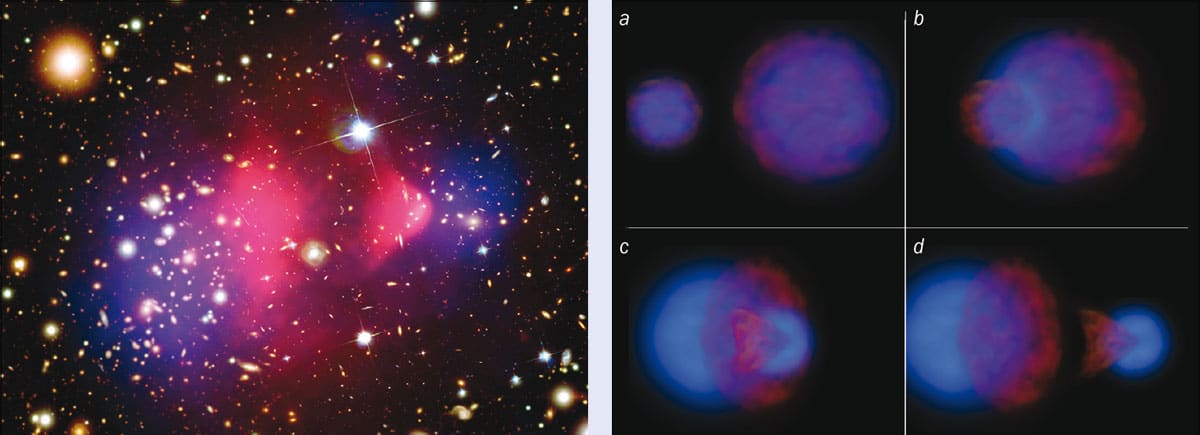
The power of weakness
In the most powerful examples of gravitational lensing, it is plain to see that very strong lensing is occurring. Galaxy clusters, such as Abell 2218 (see lead image), are the strongest lenses we know and provide us with the most striking images of this gravitational physics in action. The giant arcs that encircle these clusters show the highly distorted light emitted by distant galaxies situated almost directly behind the cluster.
But in our goal to map dark matter, we would be left with a very patchy map if galaxy clusters – which are fairly scarce – were our only indicators of mass. Thankfully, every galaxy tells us something, even if it is only mildly distorted, showing that a relatively small amount of mass lies between us and that galaxy. In fact, most distant galaxies are only “weakly” lensed and it is these galaxies that we mostly rely on to make dark-matter maps. Still, even with these weakly lensed galaxies, how do you know if an elliptical galaxy, say, looks that shape because it actually is that shape, or because its light has been gravitationally lensed?
Help to answer this question comes from the other galaxies in the neighbourhood. Imagine light travelling towards us from two nearby galaxies. As it journeys across the universe, the light will pass by the same structures of dark matter, and hence experience the same gravitational distortion. So when we look at those two galaxies in the sky they will appear to be weakly aligned, with the level of alignment increasing with the amount of dark matter they have passed. If there were no dark matter in a particular patch of the sky, the average galaxy shape would just be a circle, assuming that galaxies are randomly oriented in the universe. With dark matter, however, we find the average galaxy shape is an ellipse. The stronger the average galaxy ellipticity is in the patch, the more dark matter there is in that region of the universe. This induced ellipticity is a faint signature that dark matter writes across the cosmos to tell us exactly where it is and how much of it there is.
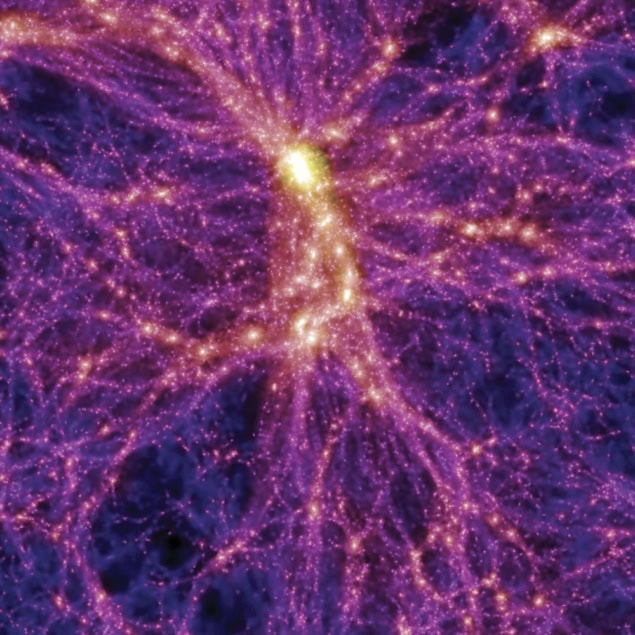
The biggest map of dark matter to date, made using this weak lensing technique, was the very result that caused my son’s abrupt outburst. Over five years from 2003 to 2008, the absolute best weather at the Canada–France–Hawaii Telescope in Hawaii was reserved to map dark matter. By analysing the weak alignment of the images of over 10 million galaxies, whose light was emitted when the universe was only six billion years old, we had our first direct glimpse at dark matter on the largest of scales. The survey revealed a cosmic web of dark matter in each of the four directions we looked. Our map exposed massive clumps of matter, wispy filamentary structures joining them together, and expansive voids between them spanning millions of light-years (2013 MNRAS 433 3373).
Even before these observations were complete, theorists had simulated dark-matter maps by taking our best theories about the nature of dark matter and using supercomputers to build a dark universe, allowing it to grow and evolve. These computer studies, such as the Millennium Simulation in 2005, had provided us with a glimpse of the invisible dark side, predicting the giant cosmic web we saw in our observations. In fact, theorists had also predicted another feature we saw in the maps: the visible universe largely overlaps with the dark universe, because the dark-matter web has dictated when and where the visible universe should form.
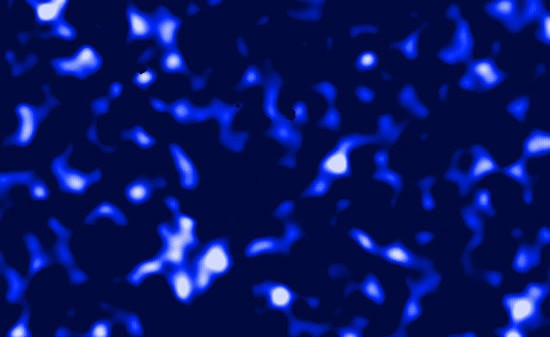
As for dark energy, it too has an important role to play in the cosmic web of dark matter. In a universe without dark energy, the clumps of dark matter would be even more dense than they are now due to the attractive forces of gravity causing the densest regions to accrete neighbouring structures of matter. But dark energy – the mysterious source of energy that is causing the post-Big Bang expansion of our universe to accelerate – slows this process down. Together, the two dark entities play out a cosmic battle of epic proportions. While the gravity of dark matter slowly pulls structures together, dark energy causes the dark-matter structures to get further and further apart, making it harder for them to grow.
Looking further away in our universe is the same as looking back in time – with gravitational lensing surveys so far having mapped objects as far away as when the universe was only six billion years old. This technique has therefore let us map dark matter in different epochs in the history of the universe. So by studying the evolution of the dark-matter web we have been able to measure how dark energy has affected the growth of those structures, and we are slowly learning about what this mysterious dark energy could be.
Technical challenges
Gravitational lensing has been heralded as the most powerful technique for studying the dark universe, but it is also the most technologically challenging. The typical distortion induced by dark matter, as a galaxy’s light travels through the universe, is only enough to alter the ellipticity of that galaxy by less than 1%. But in the last few moments before that light is captured on Earth, the atmosphere, telescope and detector can together change the ellipticity of the galaxy by 10% or more. So to isolate the alignment signature that dark matter imprints, we need to model all the distortions introduced by technology and the atmosphere to very high precision and then invert these terrestrial effects to accurately recover the cosmological signal. Just to up the ante, the terrestrial effects change every second as the wind and ground temperature alter the density of the air in different layers of the atmosphere, and the telescope slowly moves to track the rotation of the Earth.
Gravitational lensing has been heralded as the most powerful technique for studying the dark universe, but it is also the most technologically challenging
Furthermore, this lensing effect is so weak that to detect it we need to analyse the images of hundreds of millions of galaxies, which involves rapidly processing petabytes of data. For the past decade, however, astronomers have been setting “big data” challenges to crowd-source the best minds to solve this monumental computational task. In 2011, for example, the Kaggle “Mapping Dark Matter” challenge saw 700 non-astronomers competing for a prized tour around NASA’s Jet Propulsion Laboratory. Their submissions fuelled a new range of machine-learning ideas for the astronomers to put into practice.
One final astrophysical challenge persists, which the astute reader will have already recognized. How valid is our assumption that galaxies are randomly oriented throughout the universe before their light is lensed? We know that the way galaxies form and evolve depends on their local environment, and hence two galaxies in the same district of the universe may well have a natural-born alignment with each other. However, we have measured this effect by looking at the alignment of galaxies in tight-knit communities, in contrast to the alignment of galaxies widely dispersed throughout the universe. What we found was that the average natural alignment between galaxies is roughly 100 times smaller than the observed alignment that dark matter induces. This is small, but not negligible and we do take it into account (2013 MNRAS 432 2433).
Current and future missions
Three lensing teams are currently competing to be the first to reveal the next major leap in our understanding of the dark universe. Researchers from Europe (with their Kilo-Degree Survey) and from Japan (with their Hyper-Suprime Cam survey) are imaging 1500 square degrees of the cosmos – nearly 5% of our sky and 10 times as much sky as our current best lensing survey. Astronomers in the US, with the Dark Energy Survey, will eventually cover three times that area. All three surveys will conclude their observations over the next few years.
Lensing teams are competing to be the first to reveal the next major leap in our understanding of the dark universe
There is great interest in whether these surveys will uncover the same “tension” that we see between current lensing observations of the invisible dark universe and the Planck satellite’s observations of the cosmic microwave background. Gravitational-lensing surveys are very sensitive to how dark matter clumps, but the Planck data imply a much clumpier universe than the lensing surveys are currently seeing. This lack of agreement could mean a flaw in one or both of the methods. If it persists, as the methods and data quality improve, it has been speculated that this could be evidence for the existence of a new type of neutrino called the sterile neutrino. (See “What’s the matter?” Physics World July 2014, pp30–31.)
Over the next decade, three major new international projects will work in tandem in the final stages of our quest to understand the dark side. The Euclid satellite will be launched above the atmosphere, providing Hubble-Space-Telescope-quality imaging across the whole sky. Getting above the atmosphere gives us a much clearer view of the universe, and the keen vision of Euclid will be extremely sensitive to the weak dark-matter distortions that we are trying to detect. Euclid will also measure the spectra – and hence redshift and distance information – of millions of galaxies with which to chart the expansion of the universe.
Meanwhile, the Large Synoptic Survey Telescope will image the whole southern sky every three nights and provide deep multicolour imaging with which to measure distances to the galaxies without spectra. Not only will this allow us to chart the evolution of dark-matter structures, but this telescope will also be able to detect killer rocks in our solar system that may one day obliterate planet Earth!
Finally, the Square Kilometre Array will provide high-resolution imaging in the radio part of the electromagnetic spectrum, with precision redshift and polarization observations that will allow us to untangle the lensing alignment signature of dark matter from naturally arising alignments. In combination, these surveys will be able to use gravitational lensing to map dark matter and dark energy over the last 10 billion years of the history of the universe, testing gravity on the largest of scales in space and time.
With 35 years still left before I retire, my hope is that I will be able to see these projects through to their conclusion and truly know the nature of the dark side. So one day I will finally be able to tell my son that I really do know what I’m talking about!
